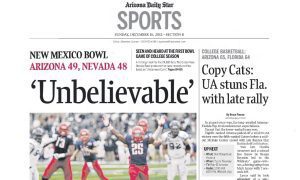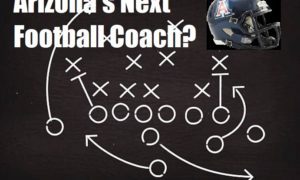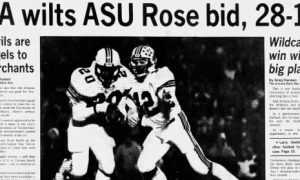FOLLOW @JAVIERJMORALES ON TWITTER!
[rps-paypal]
[ezcol_1half id=”” class=”” style=””]
In response to a recent lawsuit, the NCAA has become much more stringent on a concussed athlete’s return-to-play process this school year.
The NCAA’s revised concussion management protocol is likely affecting the playing status of Arizona starting quarterback Anu Solomon.
Solomon, a redshirt sophomore, was injured in the second quarter after sliding between two UCLA defenders with his head jolted after contacting a thigh pad of UCLA linebacker Kenny Young. Arizona coach Rich Rodriguez said after the 56-30 loss Saturday night that Solomon was in the process of being evaluated by a member of the school’s medical staff.
Rodriguez announced during his press conference Monday that Solomon suffered from a concussion and his status for Saturday’s game at Stanford is “day-to-day”.
Lawyers on both sides of a lawsuit filed by an Eastern Illinois football player in 2011 came to a proposed settlement last year. The deal reportedly included the NCAA funding $70 million toward the testing of former and current student-athletes and another $5 million to research. It was also reported the sides agreed that the NCAA would incorporate more stringent return-to-play rules.
After the plaintiff, former Eastern Illinois defensive back Adrian Arrington publicly opposed the settlement, U.S. District Judge John Lee of Chicago rejected the deal citing that it was “underfunded” and that both sides needed to devote more time to making a sensible agreement.
Arrington’s lawsuit claims the NCAA was negligent for not protecting his safety. After sustaining as many as five concussions while playing for Eastern Illinois, he now suffers from seizures, depression and headaches.
[/ezcol_1half]
[ezcol_1half_end id=”” class=”” style=””]
Site founder and award-winning sports journalist Javier Morales has published his first e-book, “The Highest Form of Living”, a fiction piece about a young man who overcomes a troubled upbringing without his lost father and wayward mother through basketball and hope. His hope is realized through the sport he loves. Basketball enables him to get past his fears. His experience on the court indirectly brings him closer to his parents in a unique, heartfelt way. Please order it at Amazon (for only $4.99) by clicking on the photo:
Heading into the weekend, there have been 44 publicly reported concussions in major college football (via @AJAM) http://t.co/y4ZwrrrbON
— Timothy Bella (@TimBella) September 25, 2015
[/ezcol_1half_end]
[ezcol_1half id=”” class=”” style=””]
Ten different lawsuits filed across the country reportedly were combined with Arrington’s case, all claiming negligence to player safety by the NCAA. The $75 million proposed settlement was reportedly a way for the NCAA to show that it was committed to a strict testing program and renewed focus on player safety.
Lee said that commitment was not strong enough and that both sides must “go back to the drawing board” for a more reasonable settlement.
The developments of these lawsuits forced the NCAA into becoming much more ironclad with its Concussion Safety Protocol Legislation, a significant reason why it is a very meticulous process for Solomon to be cleared to play. Remember when Arizona was scrutinized when Matt Scott was not immediately removed after suffering concussion symptoms, such as vomiting, during a game against USC in 2012?
[/ezcol_1half]
[ezcol_1half_end id=”” class=”” style=””]
[/ezcol_1half_end]
Here's the play that sent Anu Solomon to the locker room 2nd qtr pic.twitter.com/gbiKkZ6eWx
— AZ Wildcat Country (@Wildcat_Country) September 27, 2015
That would not happen now. Scott would be immediately removed for detailed testing by a team physician. Solomon did not even return to the sideline in the second half against UCLA despite smiling to fans and showing a “hang loose” symbol with his hands while walking to the locker room after suffering the injury.
Only a month after Lee’s ruling, the NCAA announced in January that the five Division I conferences (the “Power Five” conferences) passed Concussion Safety Protocol Legislation that “builds upon previous NCAA concussion legislation.”
The NCAA stated on its Web site under the heading of “Concussion Safety”:
“The new legislation states that each school must submit a concussion safety protocol to the Concussion Safety Protocol Committee –- also created by the legislation -– for review. … The Concussion Safety Protocol Committee met March 9, 2015, at the NCAA national office. The purpose of the meeting was to define the scope and parameters of the committee, in keeping with the new legislation, and to develop a checklist that outlines the core components for each institution’s concussion management plan.
“Throughout spring and summer 2015, the Committee assessed submissions from each of the 65 schools in the conferences under this legislation and made recommendations for improvement and for consistency with checklist and inter-association guidelines.”
Arizona submitted to the NCAA a detailed seven-page concussion management plan in May that included the school’s procedures for concussion education, acute injury management, treatment and return-to-play decisions.
DEVELOPING: Arizona QB Anu Solomon heads to the locker room after a shot to the head. #UCLAvsAZ pic.twitter.com/kBn5QdjJjR
— ESPN CollegeFootball (@ESPNCFB) September 27, 2015
Arizona’s return-to-play protocol as it pertains to Solomon’s case:
— The concussed patient will be evaluated by a team physician or designee at intervals while symptomatic and prior to return to any sports participation including exercise, weight training, individual workouts, practice or competition.
— Evaluation may include but not limited to physical examination, review of symptoms at rest/exertion, balance assessment, visual field assessment as well as review of results of neuropsychological testing.
— The team physician and/or other members of the multi-disciplinary team will take special consideration during the re-evaluation of the patient who is experiencing changing or concussion symptoms that persist for more than two weeks.
— Initially, the concussed student-athlete will have limited physical and cognitive activity until symptoms improve. An individualized patient-specific progression back into sport will be established. This progression will include the following steps without worsening or provoking new symptoms:
• Light aerobic exercise without resistance training
• Sport-specific exercise and activity without head impact
• Non-contact practice with progressive resistance training
• Unrestricted training
• Return to competition— A final exertion exercise stress test, vestibular/ocular stress test along with neuropsychological exam will be implemented at the discretion of the team physician or designee. The exertion exercise stress test along with progression will be patient-specific and sport specific. Each step of the progression and testing will be documented along with the patient’s reaction to the activity.
The meticulous process could be time consuming until the university medical staff is assured that Solomon is safe to return to contact.
If Solomon plays Saturday against Stanford, it will mean his injury was not serious and the university was only following protocol by making his return uncertain. If Solomon does not play Saturday, it means Arizona’s medical officials need more time to complete Solomon’s return-to-play procedure.
Anu Solomon made this post on Instagram Wednesday night stating: “I’m all Gucci with God on my side.”
ALLSPORTSTUCSON.com publisher, writer and editor Javier Morales is a former Arizona Press Club award winner. He has also written articles for Bleacher Report and Lindy’s College Sports.




























